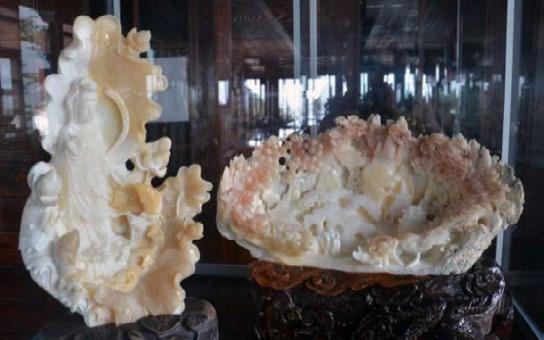
4 minute read
Smuggling routes and methods
Almost half of the reported seizures (20 cases) involved the smuggling of raw giant clam shells or shell products into China. Six of these cases were smuggled by air transport, either as air cargo or hand-carried in passenger luggage; five cases were reported to be smuggled by boat or ship, including two cases that were hand-carried in the luggage of cruise ship passengers; four cases used vehicles to smuggle products across land borders; and three cases were detected in international postal parcels. In two cases the transportation method was not specified. Only a few smuggling cases showed clear links to locations outside of China. Of these, six cases were linked to Vietnam, two to Japan, and one to the Philippines. While these cases may provide some indication of potential entry points and smuggling routes of giant clams into China, at this stage they are too few and small to be considered meaningful.
Only two cases comprised substantial volumes of contraband. In July 2018, a shipment of 2,094 raw giant clam shells was seized from a Chinese fishing vessel at Tanmen fishing port, Hainan province. The boat captain had allegedly seized the contraband from a Vietnamese vessel that had been intercepted at Xisha North Reef in the South China Sea, with the intention of selling the shells in Tanmen. The case was prosecuted
Advertisement
Figure 5: Smuggling methods of raw giant clam shells or shell products into China from January 2016 – July 2021. Image 13: Giant clam shells are unloaded from a boat in Tanmen, Hainan province, April 2013. Credit: Chen Xuelun/IC.
in June 2020 and the boat captain sentenced to three years imprisonment and fined RMB 30,000 (USD 4,625). Authorities reported the value of the shipment to be RMB 628,000 (USD 96,825).36 The source of the shells was not confirmed, but it is likely they were poached from reefs in the South China Sea.
In the second significant case, police seized 200 kg of carved clam shell products (jewellery and ornaments) from a shop in Xianyou, Putian City, Fujian province in May 2021. The seizure led police to identify the processing factory that had supplied the products in Qionghai City, Hainan province. A further 1,300 kg of raw giant clam shells was seized at the factory. Six suspects have been arrested in relation to this case.37 This seizure occurred following China’s expanded legal protection for an additional five giant clam species, and it is the only case reported during the research period in Fujian province, where an important retail market is believed to exist. Along with the further investigation to identify the processing factory, this could indicate that Chinese law enforcement may be increasing its focus on this issue. The significant seizure of raw shells from the factory also suggests that the supply of shells to the carving industry in Hainan has not stopped, despite the enhanced regulations introduced in 2017.
Several seizures in Dongxing City, Guangxi Zhuang Autonomous Region indicate that smaller volumes of giant clam shells have entered China from Vietnam, both by boat at Dongxing’s wharf and overland by vehicle. For example, a seizure of 26 large raw giant clam shells was made in September 2018, when two Chinese subjects were caught transporting the shells by tractor from Jiujiehe Wharf to an unspecified logistics company for onwards transportation in China. They had been recruited by a third Chinese subject, who was allegedly working for an unknown Vietnamese suspect. All three Chinese subjects were prosecuted and in March 2019 sentenced to two years imprisonment (suspended for two years) and fined RMB 20,000 each (approximately USD 3,076).38
However, the general lack of large seizures of raw giant clam shells in the past six years specifically within China, whether harvested by Chinese fishing fleets in the South China Sea or those that may potentially be smuggled by vessel from the Philippines or elsewhere, indicates that shipments are not being detected upon arrival in China or during their distribution once successfully smuggled into the country.

Image 14: 26 large giant clam shells seized in September 2018 in Dongxing City. Credit: Dongxing Customs.
36 https://wenshu.court.gov.cn/website/wenshu/181107ANFZ0BXSK4/index.html?docId=948aeba74ded4056b5dcacc401295637 37 https://v.qq.com/x/page/f3246zd7eoe.html 38 https://wenshu.court.gov.cn/website/wenshu/181107ANFZ0BXSK4/index.html?docId=a243ad3472ec4e0b9c6caa8e0033214d
Significant seizure of giant clam shells in 2014
A significant seizure of 250 tonnes of giant clam shells occurred in August 2014, although it took place prior to the research period and has not otherwise been included in the analysis for this report. The Hainan coast guard made the seizure after stopping and inspecting a Chinese ship near the north of Zhongjian Island in the South China Sea. The captain was charged with illegally transporting the shells without a permit, and in November 2018 was fined RMB 1,120,500 (USD 172,344) based on three times the estimated value of the shipment (RMB 373,500, equivalent to approximately USD 57,448). The captain attempted to appeal the case on the grounds that the shipment was not clam shells but “fossils”, and there was no evidence that they were intended for sale, but the court dismissed the appeal. The case is noteworthy due to it being the only example of a large volume seizure that China has previously made, which is on par with the size of the more recent Philippine seizures.39











